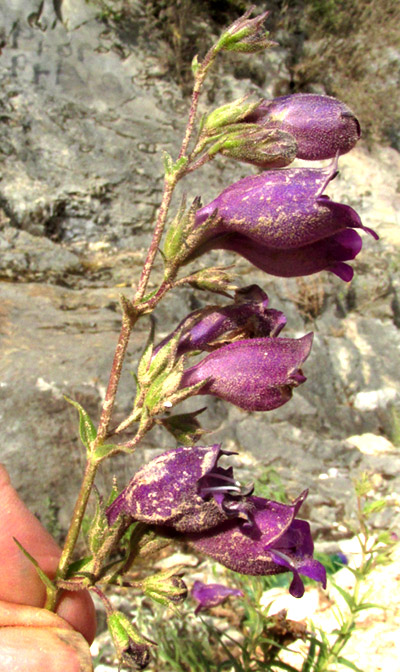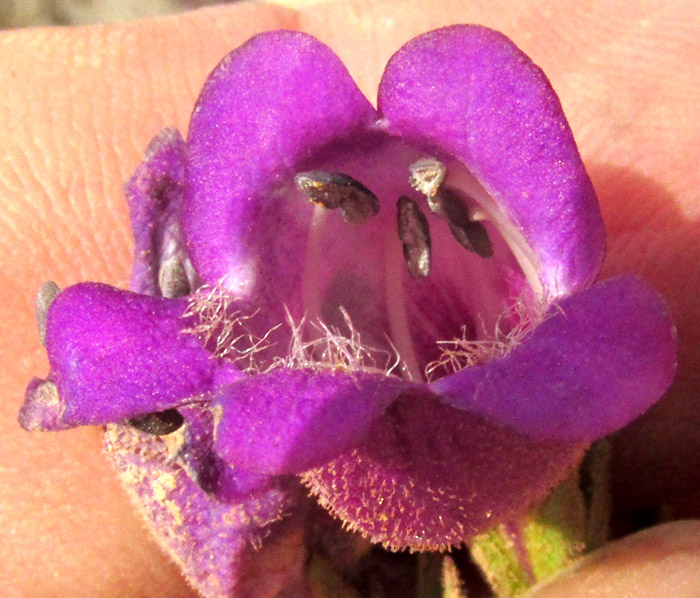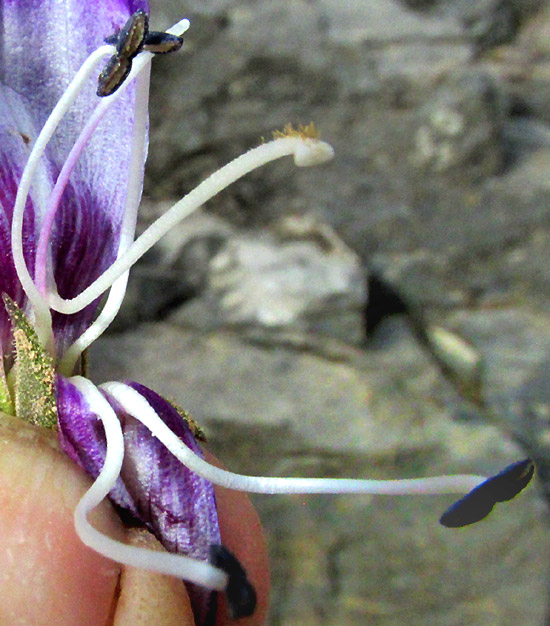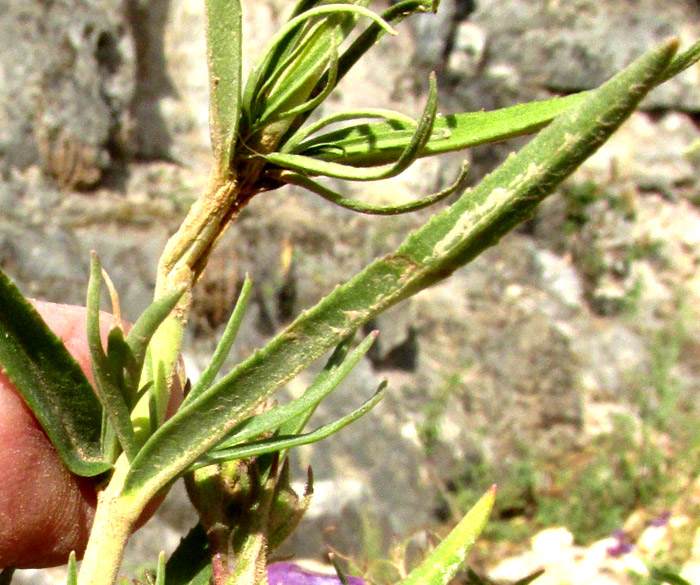Excerpts from Jim Conrad's
Naturalist Newsletter
Entry from field notes dated June 28, 2023, taken beside gravel road running beside the crest of the ridge rising on the southwestern side of Curva de la Doctorcilla, which is near km 18 on the branch road beginning at El Campamento and continuing to El Doctor, and which is numbered Hwy 120, though it branches off the main Hwy 120 running between San Juan del Río and Jalpan; limestone bedrock; elevation ~2930m (~9600 ft), Querétaro, MÉXICO, (N20.85971°, W99.60541°)
BELLFLOWER BEARDTONGUE

Beside the narrow gravel road cut into the ridgetop's limestone, the above wildflower provided the only color other than the landscape's gray and green, and the blue sky with its white clouds. This was a very dry place during a severe drought, and so exposed to intense sunlight and wind rushing across the ridge crest just a stone's throw upslope, that one had to admire this wildflower's ability to survive here.

Its flowering head was of a complex type that most plant families can't produce. It was a thyrse-type inflorescence, with clusters of short-stalked flowers arising from the main stem, and within those clusters the flowers arose on secondary axes, forming cymes. Cymes are inflorescences with their own central stem bearing a single terminal flower that develops first, with later flowers developing below it. Note that the corollas are bilaterally symmetrical, producing bulging "bellies" on their undersides.
Probably the white blotches on both flowers and vegetative parts are caused by road dust, which is derived from limestone. Dust developed off limestone is basically lime, which is caustic with a high pH. A saturated solution of lime has a pH of over 12, and can cause tissue-destroying alkali burns with discoloration.

A peep into a corolla reveals four stamens with large, dark anthers atop white filaments curving up against the corolla tube's ceiling. Such blossoms are pollinated by bees or other hymenopterans, which the corollas cater to not only by providing a lower-lip landing pad but also long hairs which can keep the pollinator from slipping off the otherwise smooth corolla floor, while scrambling toward the nectar down below. The corolla's throat is whitish inside, making things more visible.

Above, a split-open corolla shows the four stamens' filaments attached at their bases to the corolla's sides, not arising from below or atop the ovary as in most flower families. As the picture's left side, the slender item not tipped with a blackish anther is the style rising from atop the ovary, which is hidden at the base. The style is tipped with a modest, hardly discernible stigma. The white item slightly thicker and shorter than the four filaments and style, and pointing toward the picture's top, right corner, is a special kind of sterile stamen lacking an anther, called a staminode. The staminode tip curls into a flat-topped form looking more like a stigma than the stigma. Note the golden hairs atop the staminode's tip. Those hairs account for the common name of this plant. But first, a look at the leaves and stem:

Leaves arise opposite one another and, important for recognizing this species, are the numerous low, widely spaced teeth along the leaves' margins.
The genus to which this wildflower belongs was one of the first I learned to recognize as a young naturalist back in Kentucky, because some of its species were a conspicuous part of the local flora. With the flowers' bilaterally symmetrical, wide-open corolla tubes occupied with four stamens and a "bearded" staminode, such plants were known as beardtongues, genus Penstemon. For me, beardtongues became archetypal of the Foxglove/Figwort Family, the Scropulariaceae. "'If it looks like a beardtongue,' I'd say to myself in the field when meeting a plant I didn't know, 'it must be a Scroph.'"
So imagine my incredulity when modern genetic analysis decreed that beardtongues weren't Scrophs at all. Now they've been assigned to the Plantain Family, the Plantaginaceae. And plantains, in my mind, are like the Redseed Plantains we had up in Texas. One doesn't want to believe the genes, almost.
So, about 280 beardtongue species, genus Penstemon, are recognized -- all endemic just to the Americas -- of which 239 are documented in North America, some 58 are registered for Mexico, and just in our part of upland central Mexico we have 15 species. And in our area, if you have a Penstemon with such a blousy, big-bellied corolla tube, the leaves' bear those low, widely spaced teeth all along the margins, the stems are hairless or nearly so, and the leaves are narrow like those in the picture, you have PENSTEMON CAMPANULATUS, sometimes known as the Bellflower Beardtongue,
Bellflower Beardtongues, despite bearing an English name, are endemic just to upland Mexico, from the northern states south into Chiapas. The English name results from Bellflower Beardtongues being gardening favorites. They're advertised as compact, evergreen to semi-evergreen perennials or sub-shrubs, which can be grown easily in average, dry to medium, well-drained soils in full sunlight, and exhibiting an excellent tolerance for drought. The species' main weakness appears to be that in wet, poorly-drained soils plants can develop root rot and other fungal diseases.
In the 2011 study by Mariana Domínguez and others entitled "Anti-inflammatory activity of Penstemon gentianoides and Penstemon campanulatus," it's reported that Mexican indigenous people use our plant for its anti-inflammatory effects, and to reduce rheumatic pains. The author's study found that compounds from the plant's roots "inhibited mouse ear edema," during standard laboratory tests for anti-inflammatory activity.